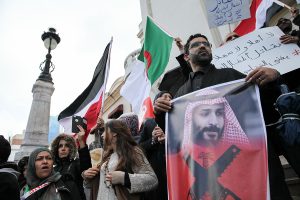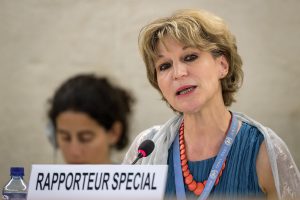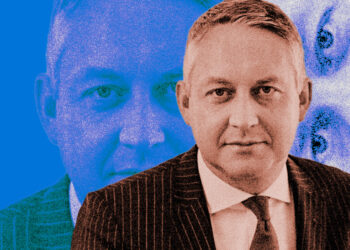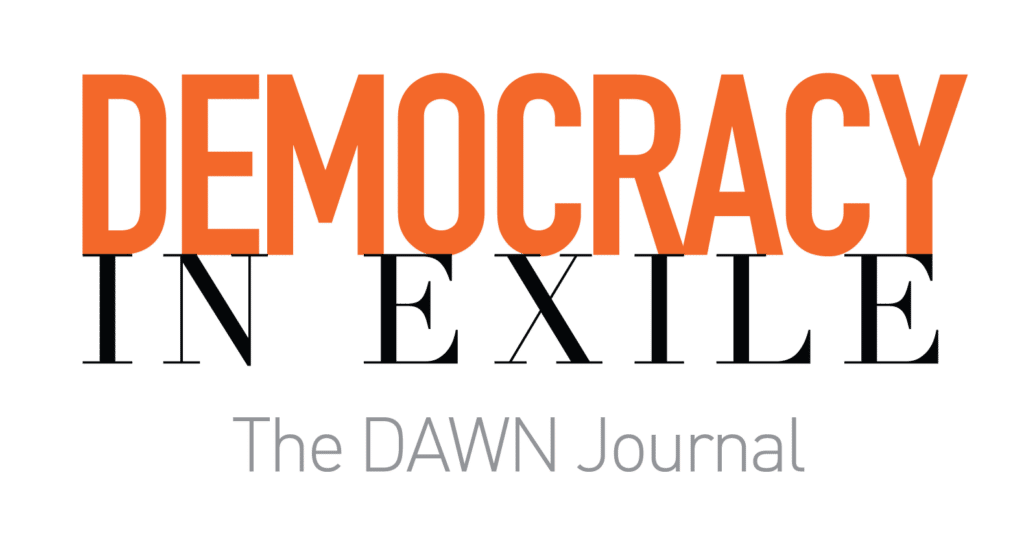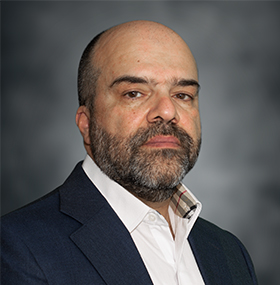Omid Memarian, a journalist, analyst and recipient of Human Rights Watch's Human Rights Defender Award, is the Director of Communications at DAWN.
عربی
"It's not easy becoming an artist no matter where you are," explains Mohammed al-Hawajri, a Palestinian artist living in Gaza, in an interview with Democracy for the Arab World Now (DAWN). "But it is more complicated and difficult in Gaza. An artist needs freedom, which is the lung from which he breathes, and which is the main engine for his ideas."
Discussing his life as an artist, al-Hawajri sees an opportunity to fill the void of art and culture in Gaza today. Al-Hawajri's work has not only been impactful in his home country but also in exhibitions around the world, including in major installations in Europe, as chronicled by the BBC in 2014.
"Art is the large flowering garden to which people flee from their daily concerns," he says. Unfortunately, the harsh and daily concerns of Palestinians living under the occupation are sometimes overwhelming. Through his art work, al-Hawajri tries to provide a measure of escape and an outlet for the imagination.

Born in 1976 in Gaza, al-Hawajri received his primary education in United Nations Relief and Works Agency (UNRWA) schools in Al-Bureij camp in central Gaza. He has been passionate about art since his childhood. In 1994, he enrolled in training programs to learn drawing and painting in Gaza City. Between 1996-1998, he was selected to work on a project to paint murals in the women's institutions and centers affiliated with UNRWA. There he gained great skills and experience from the Japanese artists who directed the project.
In 1999, he was selected to participate in the summer academy organized by the Khaled Shoman Foundation, at Darat al-Funun in Amman. The program was supervised by prominent German-Syrian artist Marwan Kassab Bachi, under whom al-Hawajri studied and learned.
In an interview with Democracy in Exile, al-Hawajri discusses his childhood, how and why he became an artist, and his career in Gaza.
Excerpts from the interview follow:

You initially believed that you should separate art from politics, but that changed over time. What made you believe art and politics are very much intertwined?
Actually, I don't want my artwork to be linked to politics, especially because if it is, it will lose its basic idea. In many of my works, I try to express myself as a person and as an artist who has his own life. This is relatable to other people's lives because I lived the same conditions and have the same concerns. There are ideas and topics from childhood memories that I like to transform into works of art in search of myself through them. I also use my art to immortalize these memories, but mostly for my children to know them.
However, it seems that the person who lives in constant volatile conditions, such as my living conditions in Palestine and especially in the Gaza Strip, has no choice. Politics is part of daily life as our lives are influenced by everything that is political. I can be sure that there is nothing in Gaza that is not politicized and, therefore, I cannot find an escape from the reality that imposed itself unto my artwork. We know that an artist must be more honest in portraying his issues, which come from the reality of people.
Since 2000, my artwork began to take a special form by addressing public issues. Here, I would like to stress that I have become preoccupied with the humanitarian issues of the people in Gaza. This became clearer through my artistic projects since 2010. Houdoud Al-Sabbar (The Limits of the Cactus) was my first multimedia project in response to everyday life in the Gaza Strip that was created with a kind of black irony through which I express everything that is going on around me. This became evident in subsequent artistic projects such as the Red Carpet project in 2014, the Guernica-Gaza project in 2013, We Will Live What Remains project in 2014, the Lion of Gaza project in 2015, and other projects that have not yet been completed as I wait for the right time to produce them as an addition to my career.

What's it like being an artist in Gaza? What are the challenges you deal with regularly?
It's not easy becoming an artist no matter where you are, but it is more complicated and difficult in Gaza. An artist needs freedom, which is the lung from which he breathes and which is the main engine for his ideas. For this reason, living as an artist in Gaza is very difficult without an environment that supports art, and freedom.
Gaza does not have the elements of artistic life. There is no theater, no cinema, no galleries, no museums, no art institutions, and no support from the government for art.
However, I understand that there are priorities in Gaza. The most important of these priorities is to provide a decent life for people. Despite this, there is no decent life for people. We have a travel ban. For more than 15 years, we have been living under a stifling siege, which has made us lose many opportunities and made us very weak in many ways. To live as an artist in these circumstances is considered an achievement because it is a great challenge in light of what I mentioned above. However, I always feel that I am a lucky artist to live in Gaza. It is an inspiring place for me because of its contradictions and changes. This makes me more creative because this special life can be used in building artistic ideas, making me different from my fellow artists. I find this matter positive and a catalyst for the production of a special kind of art that addresses humanitarian issues aimed at reaching the world with a message that art is a way of dialogue and a way of incentivizing questions through cultural exchange.

Every time I produce an artwork, I feel special, making me proud to be an artist in Gaza.
Finding the basic art materials an artist needs to produce his artistic work is difficult, among other challenges. Despite the lack of tools, these circumstances made me find creative solutions. As necessity is the mother of invention, I created my tools using household food spices and produced a whole exhibition under Soul and Smells. This exhibition was a great success because the artworks were scented. The smells added another dimension to the work, which made it more distinguished.
Also, I had another experience in using dead animal bones in my sculptures. These works were astonishing to the public in Palestine. Many people admired them. One of these works was acquired by the Museum of the Arab World Institute in Paris in 2009.
Whenever I am practicing my profession, I feel as if I am in an art laboratory, creating my artistic tools to satisfy my desire to continue producing art despite any circumstances.
That's why I say I'm one lucky artist.

In many of your works, we see a sense of "critical sarcasm." How did you explore this visual language, and what do you think it communicates with your audiences?
The public awaits works of art when they know the artist is from Gaza. Every time I travel to participate in exhibitions or art workshops in Europe, the audience is surprised when they find mature artworks of the same level as the works they are accustomed to seeing in the galleries in their country. This made me more insistent on developing my own artistic tools. This is why I'm always looking for tools and new ways to express my ideas and work to communicate my ideas to the world. "Sarcasm of reality" means recognizing this reality. I always try to emphasize that reality is bitter, but talking about it should be logical and not exaggerated.
So, I try to make something different from what people see through media outlets that exaggerate or underestimate the reality in Gaza.
Then comes the role of art in presenting issues in a way that people accept with a small smile. This smile may be a way for people to recognize our concerns and to closely identify the extent of the injustice inflicted on people in Gaza. I think that I have succeeded in this matter through my artwork, which has been admired by many people interested in arts and culture.

Mahmoud Darwish said, "Sarcasm helps me overcome the harshness of the reality we live in, eases the pain of scars, and makes people smile." How similar is your version of sarcasm to Darwish's created with words?
Darwish was right, mainly because the world is always in conflict, which has plunged people into many worries. I believe that a human being now doesn't have much time and is busy securing a decent living for himself and his family. This is why we find many people don't have the desire to follow world events. The role of art and artists is to provide an escape from reality in light of daily preoccupations. Artists must be innovative in presenting their artworks and creating an enjoyable experience to attract people and bring them back to their nature.
Art is the large flowering garden to which people flee from their daily concerns. So, as artists, we must create an opportunity for these people to live with us, with the same concerns, and make fun of those concerns together!
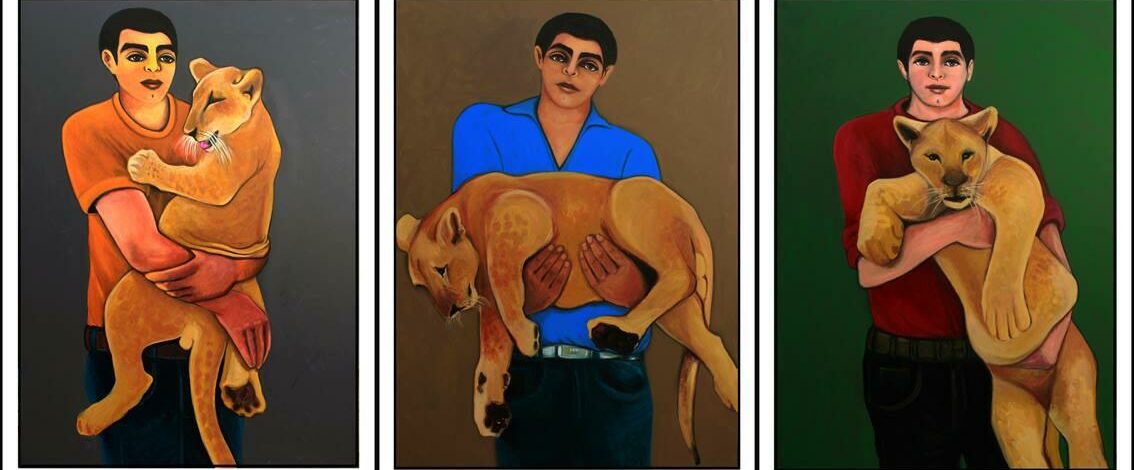
In a place that faces a bitter reality, how does your work reflect the life of the people who shape your imagination?
Who are the people? Me, you, he, she, we are all the people. Every time I express myself, I find expression for everyone. I rely on some of my artwork for memories from my childhood and also from hearing stories of the reality in Gaza. For example, a man in Gaza raised two lion cubs at his home with his children after the cubs lost their parents in the 2009 war after the zoo was bombed. The man decided to take care of the cubs. With the passage of time, the cubs grew, which meant they needed a larger amount of meat. It was difficult for the man to provide food for the lions. So, the sons of this man took the two lions to the streets and the beach, where people can take pictures with the two lions for a small fee. This helped support the family and the two lions.
One of the people posted a picture with the lions on social media. One of the Swedish associations concerned with animal care came to know about the story. So, the association sent a team to visit Gaza and make the necessary plans with the Israelis to rescue the two lions from Gaza with a special arrangement in Sweden to receive care.
Such a story made me think of how I could benefit similarly from an art project. So, I made paintings of lions with young teenagers. I want to say that I always await what is unique and distinctive, even if it's simple. My role as an artist is to shed light on stories that attract the attention of those concerned.

You have been a part of many group exhibitions in Bethlehem, Gaza, Jerusalem, Ramallah, etc., showing a vibrant artistic community in Palestine. Tell us about the art scene around you. How popular is art in Palestine? How does the general public receive artists?
Since I started my professional career in art, I have become preoccupied with producing artwork or creating opportunities with my artist friends for a generation that loves art. Since 2002, I have established an art group in Gaza, which is a group, or contemporary art meeting, that helps spread artistic awareness through organizing art events, exhibitions, workshops, dialogues, and other related activities in Gaza. This helped a lot in creating a state of awareness, and the meeting has become a house of artists in Gaza. Hence, I can say that the art scene in Palestine is active, and it is distinguished by the mounting passion of the younger generation who loves art and uses it as a refuge to express their ideas.
Every time I participate with artwork in Palestine, I have a strong sense of pride in being one of the Palestinian artists who has participated in building the cultural and artistic scene.
Over the past ten years, I have organized many cultural events reverberating worldwide. This was a reason for drawing attention to what is occurring in Palestine regarding culture. Despite lacking resources and support, we still find a significant movement within ourselves. We see this through the participation of many Palestinian artists in international art events. This makes us even prouder of the Palestinian artists, who take their artistic work to the world despite many difficult circumstances.
![]()









